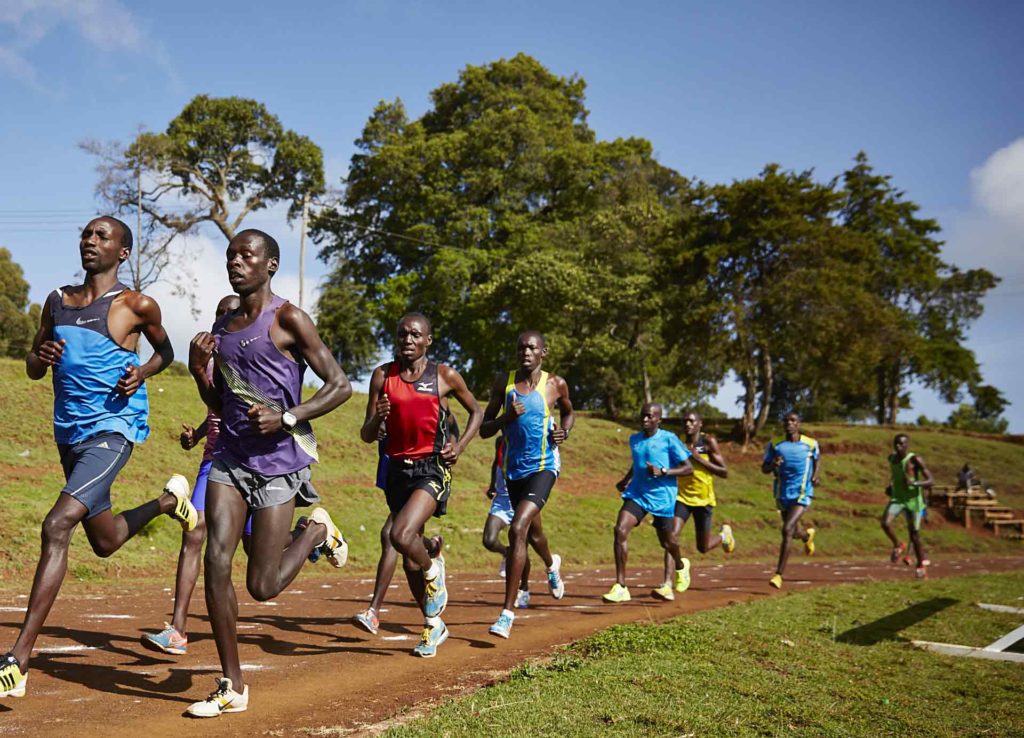
Visiting a high-altitude Kenya running camp
Kenya is the home of running. It’s also a popular venue for runners who want to perfect their marathon-running skills. This requires a visit one of the high-altitude running camps of north-west Kenya. In this blog, we take a sprint around the High Altitude Training Centre in Iten, a popular Kenya running camp.
Welcome to Iten, Home of Champions
It’s a long, grinding, pull up to Iten, the running capital of Kenya. A superbly panoramic road, smooth as silk, zigzags up the side of the Rift Valley; to a heaven-bound eight thousand feet above sea level. The views are long, hazy-blue and primeval, the air effervescent. You may see another car on the road; you may grapple solely with goats. This is the roof of the world; and you’ve got to want to climb there.
Iten itself is a compact, cheery outpost, much like any other town in Western Kenya. Except for one thing: it is ‘runners town’ and home to an impossible number of world-class athletes. Of its 2,500 inhabitants at least one third are Olympic runners; around its simple 400 m all-weather running track pound the global elite of short, long, and middle-distance running. And along its muddy rust-red tracks everyone, but everyone, RUNS.
The High Altitude Training Centre
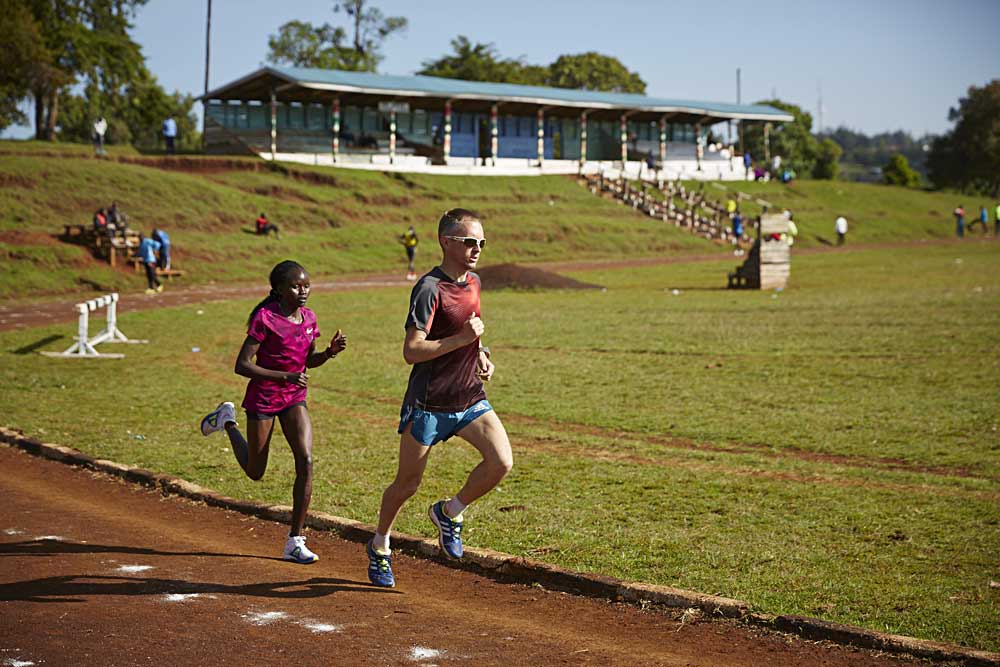
On the outskirts of town, a sign reads ‘High Altitude Training Centre, University of Champions’, and a rough road leads between high hedges. Cows bumble and browse. At the end of the lane is a gate; beyond it an extraordinarily high-tech gymnasium, a grassy lawn dotted with sun-beds, and a low stone building which houses a central dining room, recreation area and kitchen. There is even a heated swimming pool, sauna and a Physiotherapy and Injury Clinic. There’s a double row of simple rooms; outside each of them is a jumble of red-muddied running shoes.
Lornah's dream
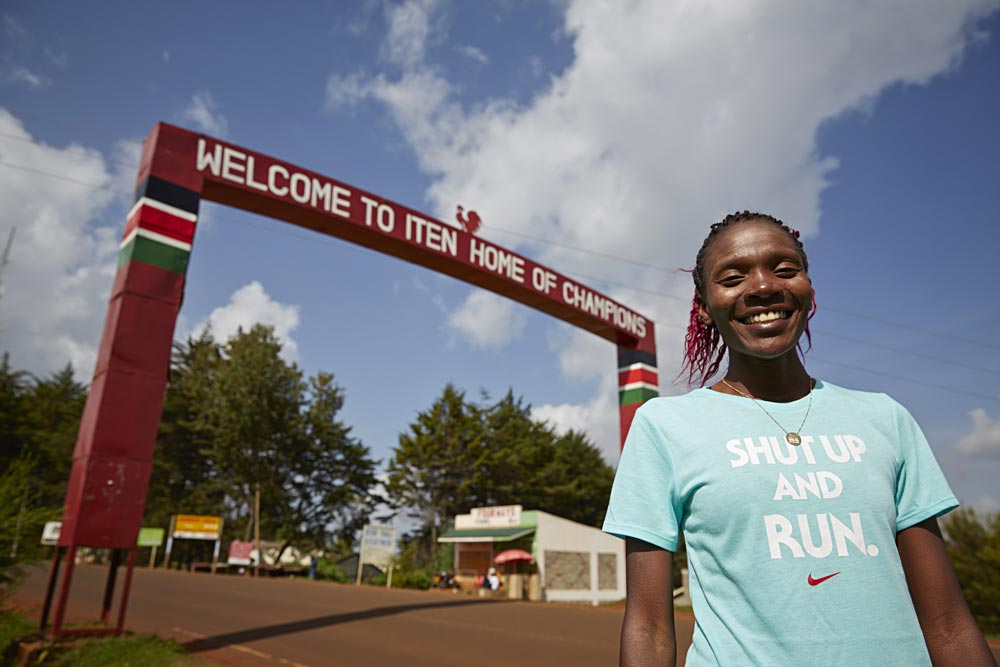
The HATC, opened in 2000, is the brainchild of ‘elite’ athlete, Lornah Kiplagat. Lornah is a four times World Champion and has held World records over 5 Km, 10 Mile, 20 Km and Half Marathon and competed for the Netherlands in the Athens (2004), Beijing (2008), and London (2012) Olympics. She also won the World Championships Cross Country in Mombasa in 2007. This is a lady who lives to run, and runs to live.
To the running cognoscenti, Iten is Mecca. It’s high, beautiful, surrounded by hundreds of kilometers of rural running tracks; and you get to run with the best in the world. The Centre, meanwhile, offers simple accommodation, professional guidance, world-class trainers, and a high-octane diet: training fuel. On each bedroom door is a sign, ‘alcohol and cigarettes are not permitted in the camp’. At dawn the doors burst open, and the runners stream out. They train from 7-11am and from 4-6pm; some on the track; some on the rural roads.
Dining is communal and timed to promote optimum performance. The food is locally sourced; simple and nutritious; high on vegetables and carbohydrates, low on protein. Dinner is at 7.30pm. Bed is early. The talk is of hamstrings, marathons, recovery times, heart rates, and under-hydration versus over-hydration. In the running game: training, fuel, water and sleep are all that matters.
And the really odd thing is … that everyone seems to be having an excellent time. It’s all laughter and light in the boot camp.
HATC Kenya running camp - Find out more
The High Altitude Training Centre offers packages based on full-board accommodation. Costs vary depending on the length of your stay and the number of people in your group. There are over 70 beds and over 1,000 miles of trails!
To find out more, visit: https://hatc-iten.com
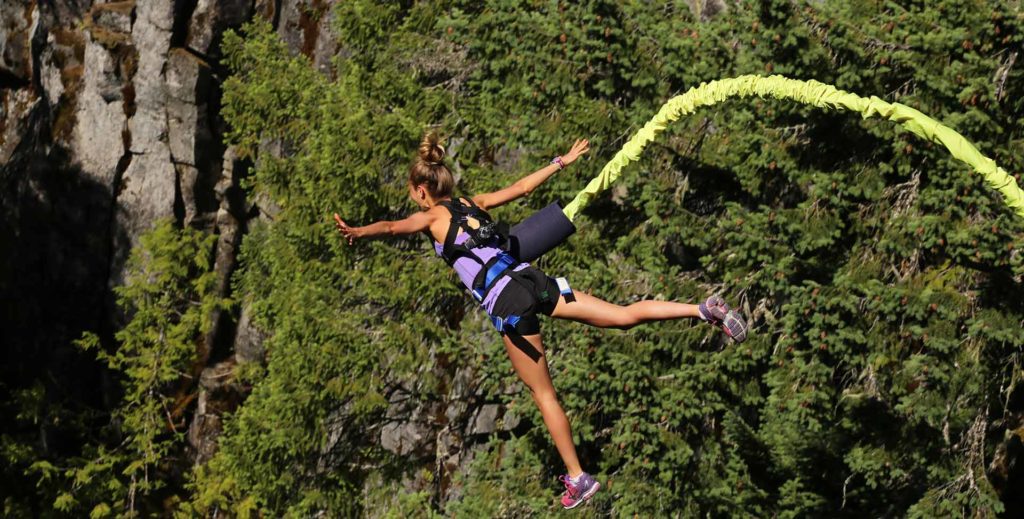
Adventure sports in Kenya
With a sublime climate, clear blue skies and stunning scenery, Kenya is the ideal place to indulge in some air-borne adventure sports. Here we look at the options for paragliding, zip-lining and jumping off into the unknown…
Paragliding over the Kerio Valley
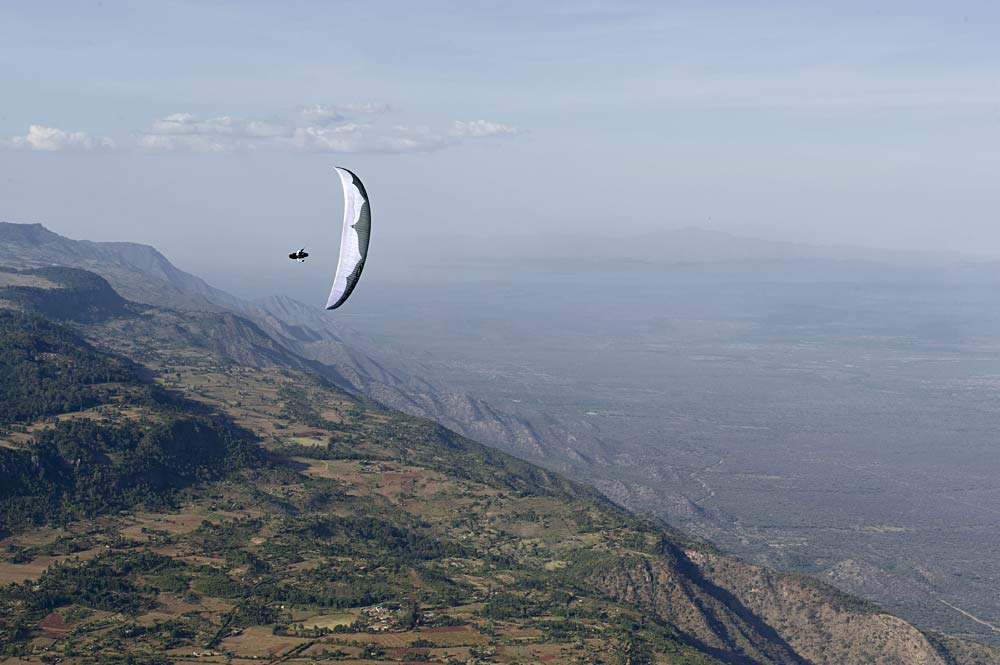
For the ultimate in paragliding experiences, you have to head for the Kerio Valley. A branch of its more famous cousin, the Great Rift Valley, the Kerio Valley drops a spectacular 1,219 metres. Lying between the Tugen Hills and the Elgeyo Escarpment, it is 80km long and only 10km at its widest. On its upper slopes is a tangle of semi-tropical vegetation. At its sweltering bottom there’s only dry bush, elephant, buffalo and the meanderings of the crocodile-packed Kerio River.
The Elgeyo Escarpment is the perfect flying ridge. Actually it is two ridges: an upper ridge dropping 200m to a shelf before the larger ridge drops roughly another 1,000m to the valley floor. In winter (December to February), the Escarpment faces the north-easterly trade wind head on creating perfect soaring conditions. The wind can be quite strong, but is typically around 15-20km/h. The arid landscape produces strong thermals, which mix with the dynamic lift.
Here, a typical paraglide will last a couple of hours and cover ten kilometres, which means that you can look down on Tiati, the sacred mountain of the Pokot people, the ancient Neolithic furrows of the Sirikwa people and the shimmering heat and dust of the Rimoi Game Reserve – which is probably Kenya’s wildest. Tandem flights can be organised.
Getting there: by road, approx. 6-7 hours drive from Nairobi; or you can fly to Eldoret and then travel around 2 hours by road.
For more information: https://www.fly-kenya.com/
Zip-lining
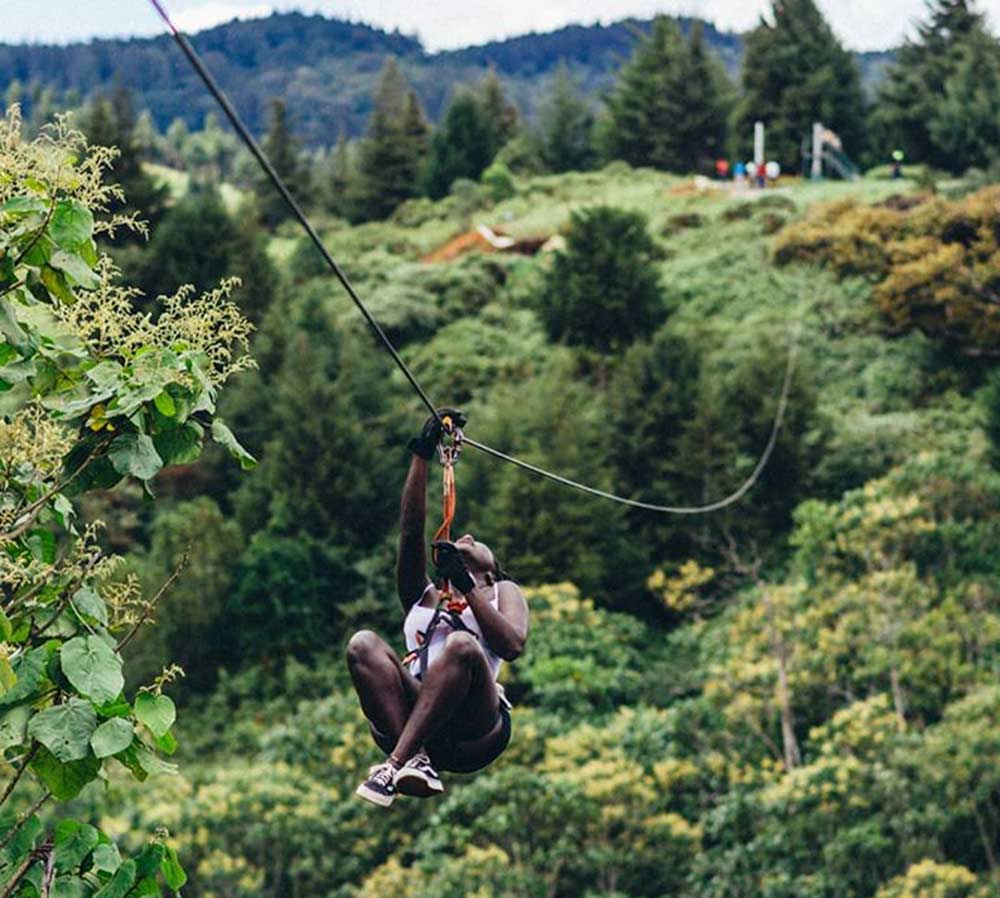
Kenya is home to some of the last remaining stands of primeval forests on earth. So, to get a bird’s eye view of them you might like to try out some zip lining. If so, head for The Forest, a Kenya adventure sports centre less than hour’s drive north of Nairobi, close to the Aberdares. Here, you can sample East Africa’s longest zip-line tour, known as Flying Fox, which soars over the Kereita Forest with a combined length of 2,200 metres. For more information, visit: https://theforest.co.ke/
Alternatively, you can fly across the Tana River with Savage Wilderness, just an hour-and-a-half from Nairobi. The zip line is 120m long and 130m high giving an exceptional view of the scenery below.
Go jump off a cliff
Well yes, you can: literally. Amid the leafy green vaults of the magical Ngare Ndare Forest, you can (with supervision) jump off a cliff into a rock pool.

For a bird's eye view of the forest, you can enjoy the 'tree canopy walk' - a 450m long rope bridge suspended 30 feet above the ground, the first of its kind in East Africa. The walk ends on a high platform where you can watch elephants wallowing in the swamp below. Or if heights are not your thing, you can simply go for a forest walk amid 200-year-old African olive and red cedar trees. The Ngare Ndare Forest is also an incredible rock climbing destination.
An ecological stronghold, the Ngare Ndare Forest stands at the foot of Mount Kenya, close to the Lewa Wildlife Conservancy. For more information, visit: http://www.ngarendare.org
Ridiculously extreme sport
For the adrenaline junkie, there can be nothing better than scampering up an 80-foot high crane, clipping yourself on to a glorified elastic band and jumping off. Alternatively, you can drop-and-dangle over the churning waters of the Tana River or the Athi River. For further information: www.savagewilderness.org

How the Maasai Olympics have aided lion conservation in the Amboseli-Tsavo region
In this article, we learn how the Maasai community has worked with the Big Life Foundation to establish the Maasai Olympics. And we see how this has had a profound impact, not only on lion conservation, but also on community empowerment.

A decade ago, a deputation of Maasai elders strode onto the ranch of a well-known conservationist. Draped in their traditional scarlet cloaks and bearing the traditional tokens of their office, it was clear that they wanted to talk. An acacia tree was chosen and, as according to custom, a meeting was held in its shade. On one side sat the elders, on the other a team from the non-profit conservation organization, Big Life Foundation. When the formal greetings were over, an announcement was made. The elders wished, they said, to end the practice of lion hunting amongst their young men. There was a stunned silence. This was unheard of.
Becoming a warrior
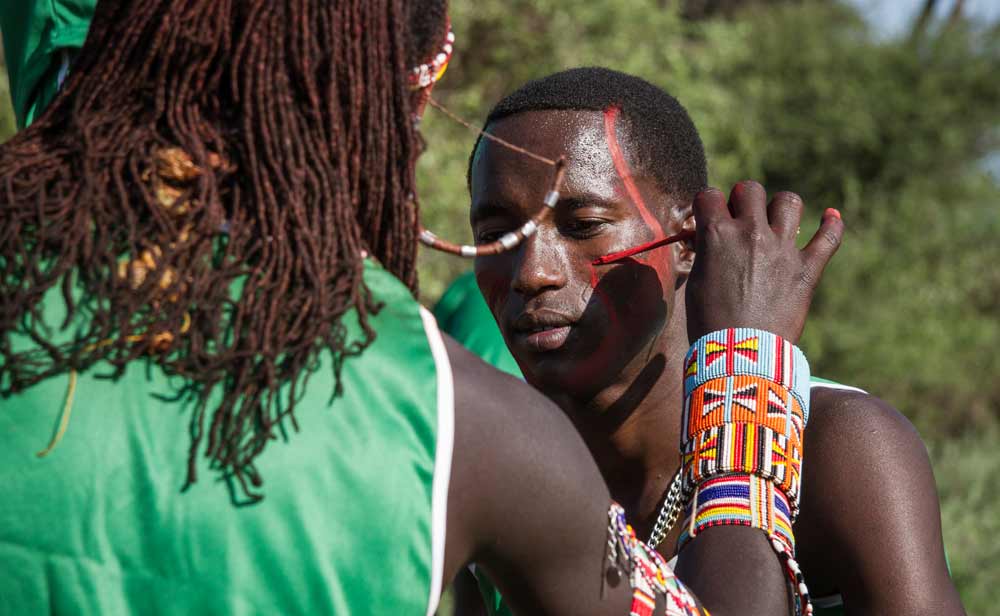
The Maasai had been hunting lions since the dawn of time. No young man could truly be considered a warrior until he had killed a lion. Furthermore, no Maasai maiden would give a second glance to one whose manhood had not been thus proven. For the conservationists, the announcement made magnificent news but it begged a rather large question: what could possibly replace lion hunting in the eyes of the warriors of this most traditional of cultures? The elders had thought this through. ‘Elsewhere in the world’, said one with elegant simplicity, ‘is it not true that boys compete for girls through sport?’ Bulls-eye: he had it in one: the Maasai Olympics sprang into life.
The first Maasai Olympics
The first event, organized by Big Life Foundation, took place in 2012 and involved thousands of young men from the Amboseli/Tsavo ecosystem. They competed against each other in the traditional Maasai pursuits of running, spear throwing and jumping from a standing position. Prizes included educational scholarships, the chance to compete in the New York Marathon and, most alluring of all, a prize breeding bull.
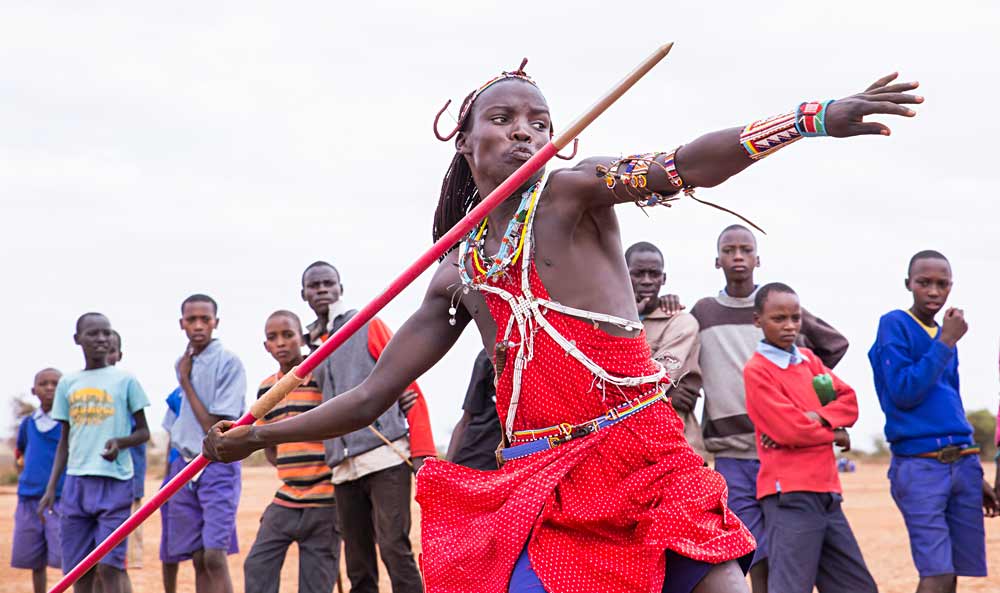
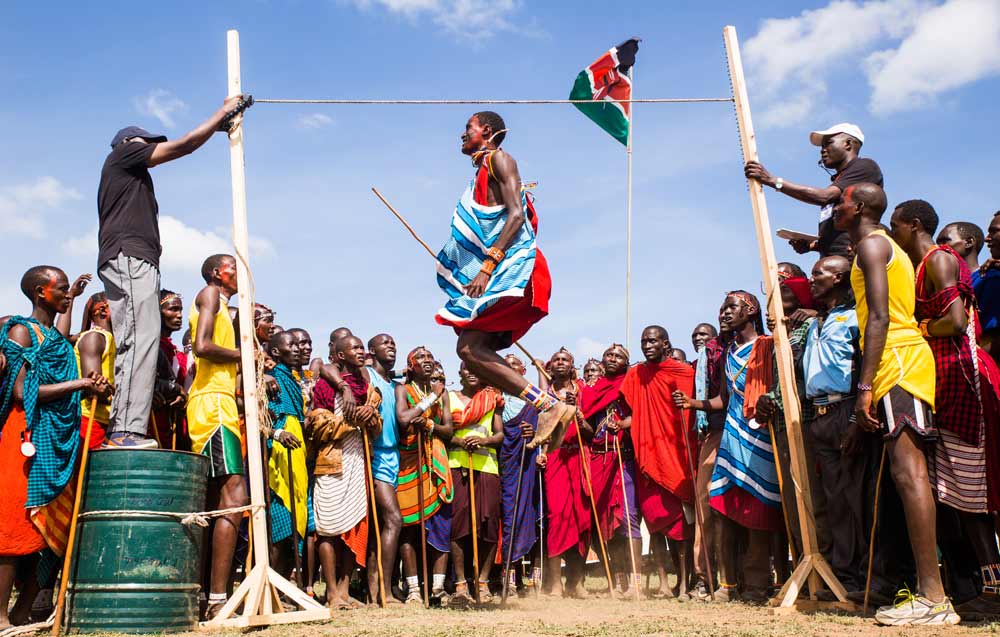
It was a huge success
The event was an unqualified success, not only as a conservation and cultural game-changer, but also as a photographic extravaganza. The spears flew, the runners pounded and the jumpers soared while the air vibrated with the low, throaty, chanting of the spectators. Meanwhile, toned to perfection, intricate of hairdo and glorious of face-paint, the triumphant Olympians strutted and preened before the ranks of brilliantly attired maidens. The response was electric: they screamed in the Maasai equivalent of Beatle-mania. The point was brilliantly made. You don’t need to kill a lion to get your girl: but you do have to protect your lion to get where you want to go.
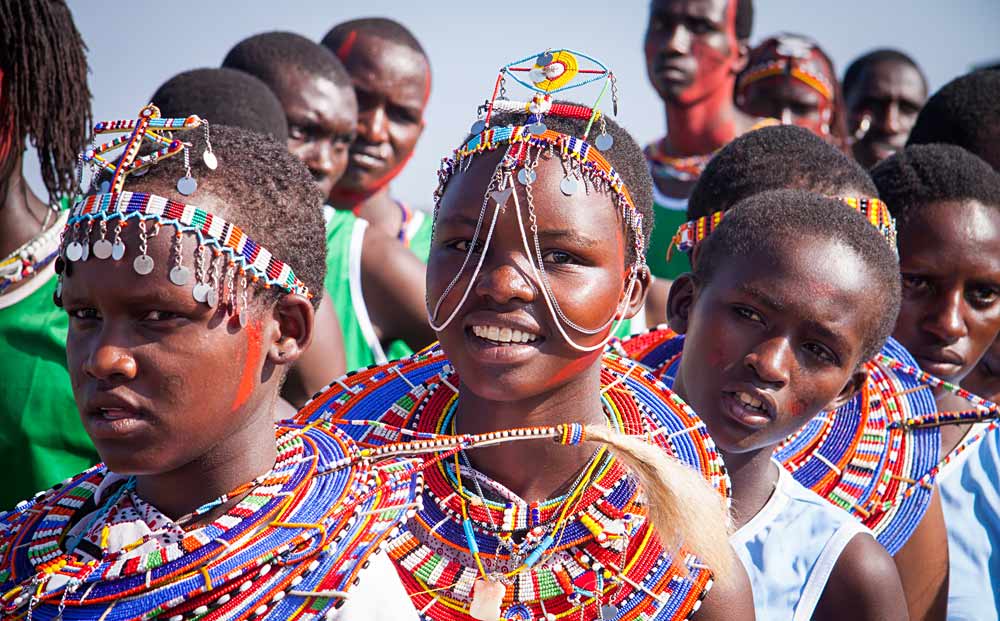
‘Why would I kill a lion?’ asked one young warrior. ‘The tourists come to see that lion and the revenue from tourism can pay for school fees.’ Another winner, carried shoulder-high by his chanting age-mates, said: ‘David Rudisha didn’t become famous because he killed a lion, but because he’s a world-class runner’. With a medal on a ribbon around his neck, a prize bull on the end of a rope, and a phalanx of admirers at his back, another young man sashayed away into the savannah as if he was leading a conga line. We’re going to dance all the way back to the manyatta,’ he said.
How the Maasai Olympics work
The Maasai Olympics are a bi-annual event and will next take place in 2020. All over Maasailand, heats are already being held to determine who will represent their village. Coaches are being selected; teams are being trained. Six regional competitions will be held from July to October until, in December, the final climax of ‘Olympics Day’ will take place. And spectators are welcome at each and every event.
But it’s not ALL about the sport. At every meeting workshops are held and insights are offered as to the crucial role the Maasai community plays in the conservation of nature. And, vice versa: how by protecting the wildlife, the Maasai empower themselves.
Thanks to the Maasai Olympics the lions are thriving
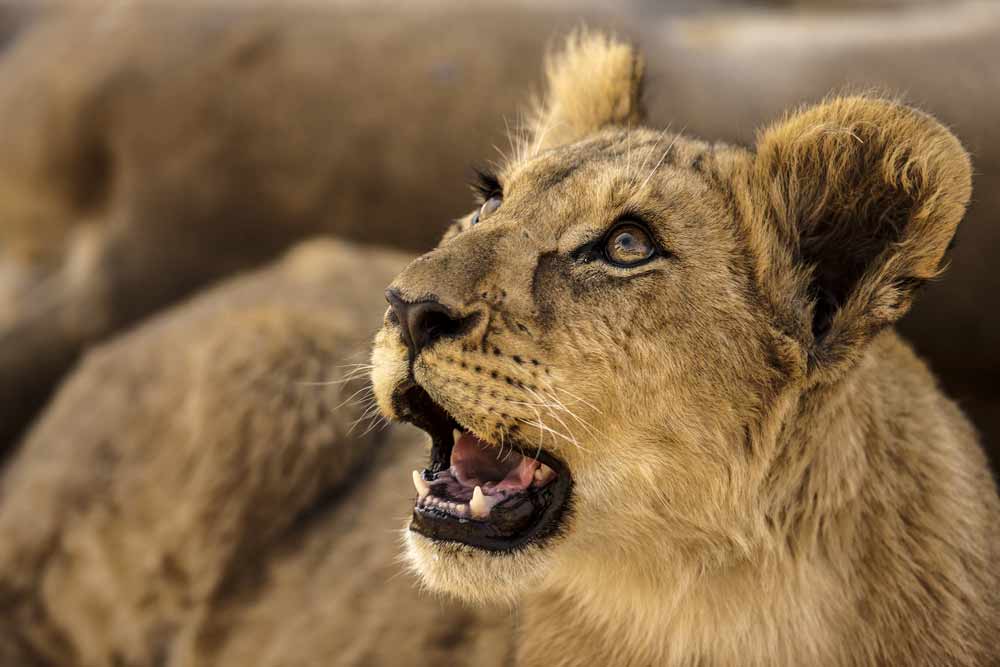
As for the lions, they’re thriving. Now that the shadow of the spear no longer hangs over them, they’ve come to accept the presence of humans with little more than a whisk of a tail. Consequently lion watching doesn’t get much better than in Kenya and tourism numbers are rising. As for the warriors, they’re putting millennia of lion-tracking skills to good purpose: they make the finest guides in Africa.
About the Big Life Foundation
Big Life was co-founded in September 2010. It bases its philosophy on the fact that sustainable conservation can only be achieved through a community-based collaborative approach. Today, Big Life employs hundreds of local Maasai rangers. It also has more than 40 permanent outposts and tent-based field units, 13 vehicles, tracker dogs, and an aerial surveillance unit—all protecting 2 million acres of wilderness in the Amboseli-Tsavo-Kilimanjaro ecosystem. Big Life is funded by donations. For more information, visit: https://biglife.org/
If you’d like to attend the Maasai Olympics or make a donation, contact: info@biglife.org
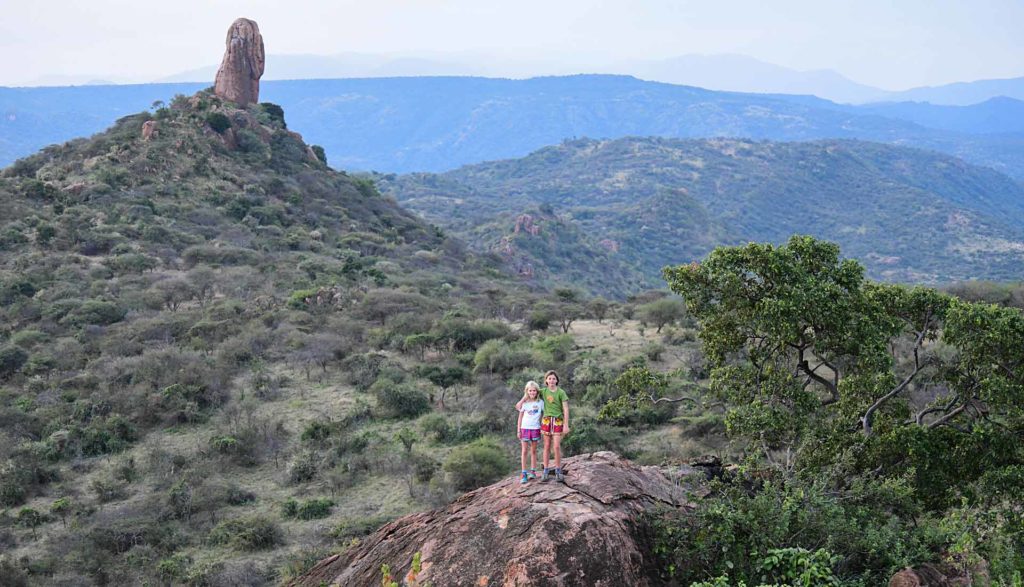
A guided walking safari in Laikipia
A walking safari in Laikipia makes a great way of seeing this enchanting region of Kenya; a great way of getting exercise too. A walking safari is also an unrivalled way of getting to know your Samburu guide. Finally, there is no better way of seeing elephants...
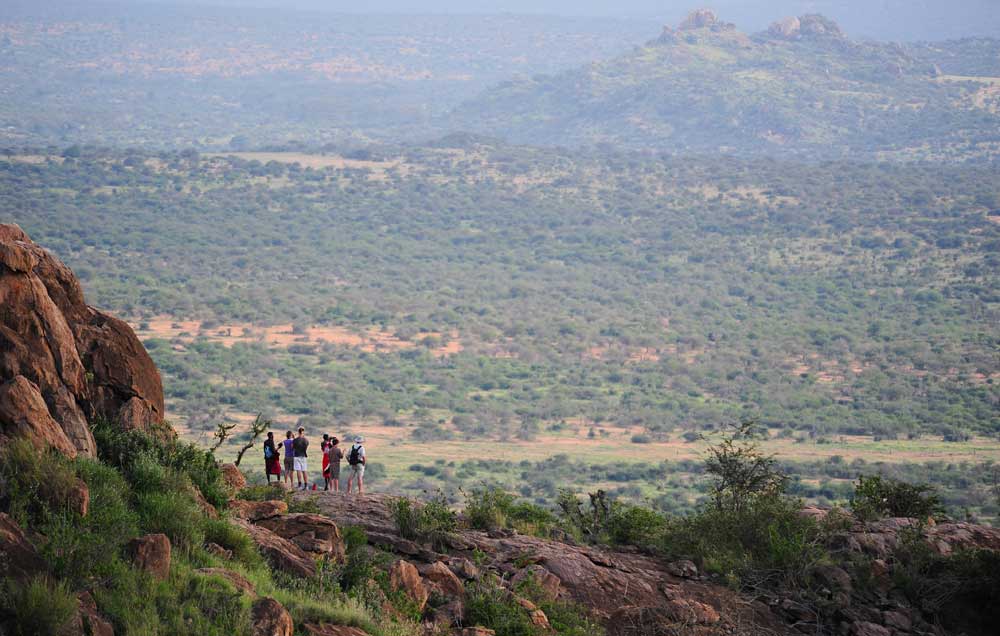
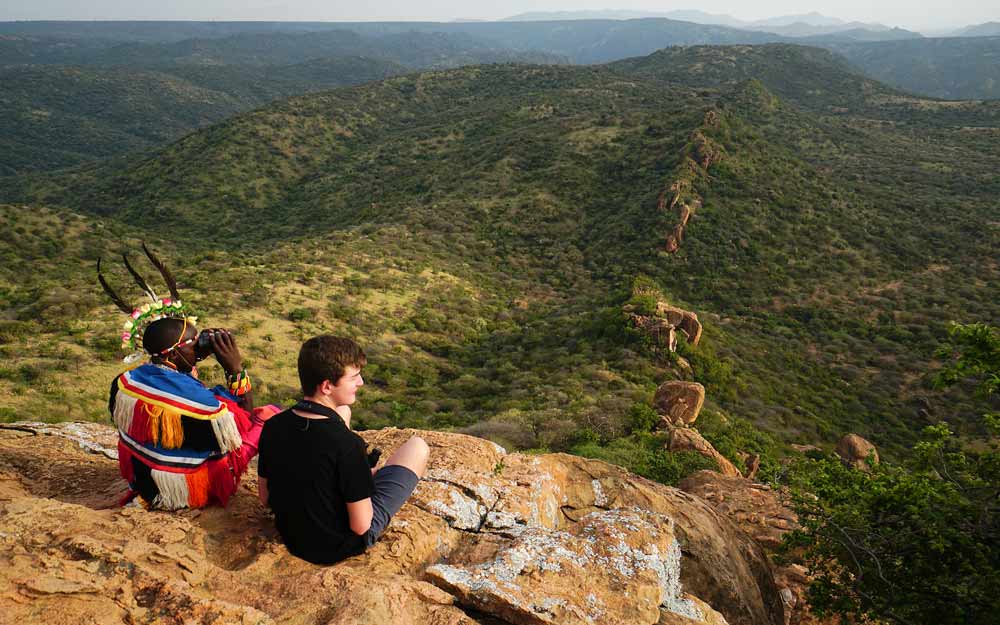
Climbing a kopje
A walking safari takes commitment. It’s a hard, clawing, slithering scramble up the kopje, a vast cluster of giant-sized golden boulders the size of an airplane hangar. The plains below Mount Kenya are littered with these outcrops. Some rear like jagged towers, others crouch like monstrous muffins. After twenty minutes of increasingly difficult scrabbling up sun-warmed rock, we’re finally on top. Buffeted by a strong wind that wasn’t present down below, we gaze out across miles and miles of rolling acacia.
Awesome is an over-used word. But in this case it does the job. Dusk is falling and the great grey shoals of hills are slowly turning pink. Shafts of silver light fan down from the heavens.
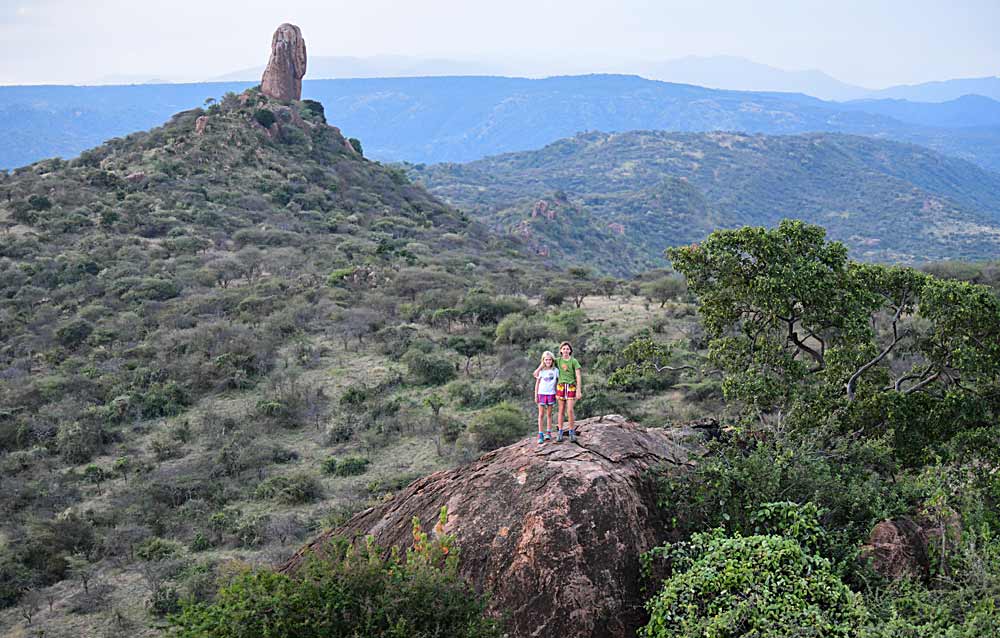
There’s another great kopje facing us. It’s the size of an Easter Island statue and resembles the profile of a gigantic baboon. Scampering up its huge face, like an outbreak of spots, is a baboon troop. There must be twenty or thirty of them and they’ll spend the night up there: safe from lions and leopards. High above, a tawny eagle circles, his wing tips flipped to catch the updraft. So perhaps they safety isn’t entirely guaranteed.
The arrival of the elephants
‘Can you see the elephants?’ asks our Samburu guide. He unslings his gun and balances it on his lap. He, of course, has known they were there all along. He’s spotted their great pancake prints in the dust, heard the cracking of branches as they strip bark. It’s his job. We, however, take several seconds of straining to disentangle the grey-brown humps of the elephants from the grey-white clumps of bush. When we finally succeed, it comes as a shock: the bush, hitherto so innocent, has revealed fifteen elephants. Quite a concealment, but then Mother Nature is the mistress of the slow reveal.
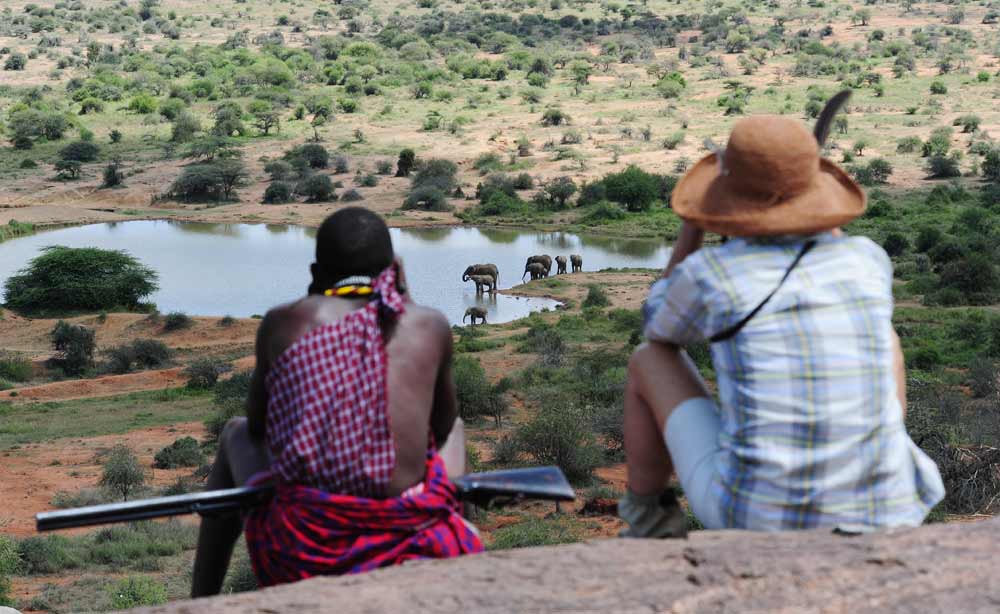
We watch as a great she-elephant uses her trunk to snap off a branch of spine-laden acacia and cram it into her mouth. It’s devoured with all the ease of a twirl of spaghetti on a fork. In the cave of her legs a baby is suckling. A pair of adolescent males twines trunks in mock fight. Sisters, cousins and aunts forage companionably together. It’s supper time at baboon rock.
The baboons show up
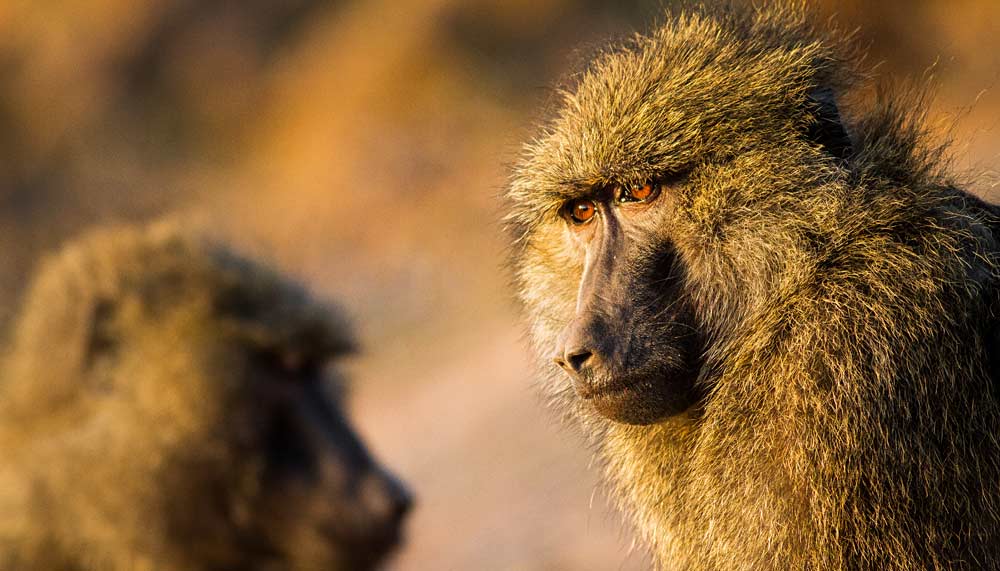
We’ve descended from the heights to a lower ledge: out of the wind, closer to the vehicle, and the young Samburu warrior who hauled us up the steeper parts of the climb is unpacking his rucksack. There’s a bottle of chilled wine, cans of Tusker lager and a large bowl of popcorn still warm from the kitchens of Karisia Walking Safaris. As the cans pop open, a face peers enquiringly over the rounded lip of the rock above. And then another, and another until the whole bulge of rock is fringed with faces. This is another troop of baboons and they’ve returned home to find somebody sitting on their ledge. After surveying us for some seconds, they retreat. They’ve met men before.
The great bull elephant arrives
Our guides are exchanging remarks. Joseph grabs his binoculars. Down the track comes a veritable giant of an elephant. He’s moving fast: ears flapping, trunk swaying. Deep in the grey tangle of bush the females seem unaware of his approach. This might be awkward. Cows don’t welcome the attention of bulls unless it’s the mating season. This bull, however, has the air of one who is not to be denied. ‘They’ll warn him off,’ says Joseph. Right on cue there’s a cacophony of trumpeting and the females draw closer together. The big bull is undeterred. He plunges into their midst until he’s trunk to trunk with the matriarch. It’s a stand-off.
Through the binoculars we can just make out the approach of a young female. She sashays up to the bull and rubs her head against his great grey ribcage. His trunk comes up and, very delicately, he sniffs her. Others females approach and there’s an orgy of sniffing. Trunks curl and wind around each other. And then, as if satisfied by the tenor of his welcome, the bull turns to an acacia tree and effortlessly rips it in two. The cows return to their foraging. Peace is restored at baboon rock.
What you need to know when planning a walking safari in Laikipia
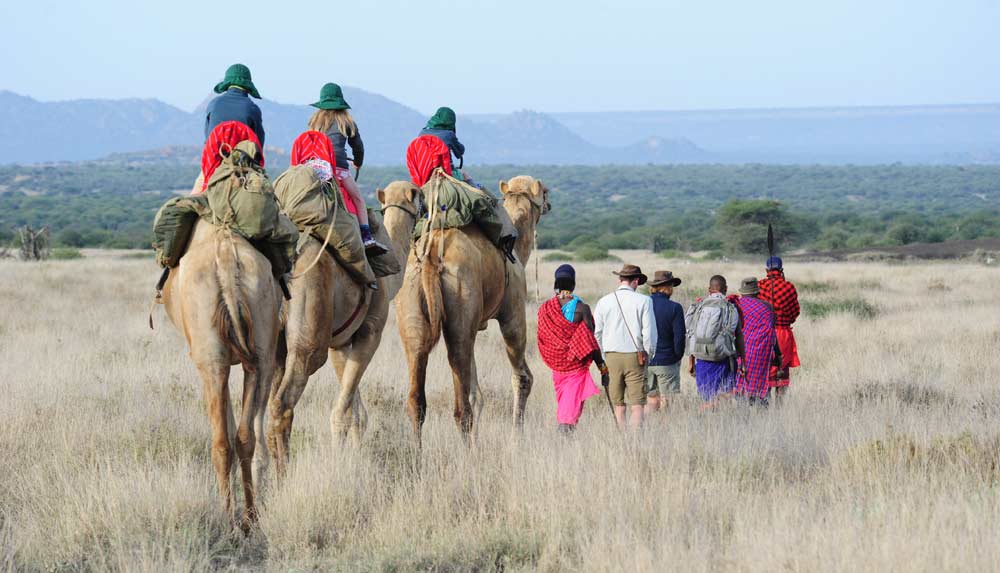
Karisia Walking Safaris, based in Laikipia County, offer bespoke walking safaris (with or without camels). It’s a superb experience, not just because the scenery is stunning and the wildlife some of the finest in Kenya, but also because you are introduced effortlessly into the colour and culture of Samburu life and to the towering magnificence of Laikipia, which hosts thousands of elephants, huge lion herds, spectacular birdlife and the largest population left on earth of endangered mammals such as Grevy’s zebra, wild dogs and reticulated giraffe.
For further information: www.karisia.com
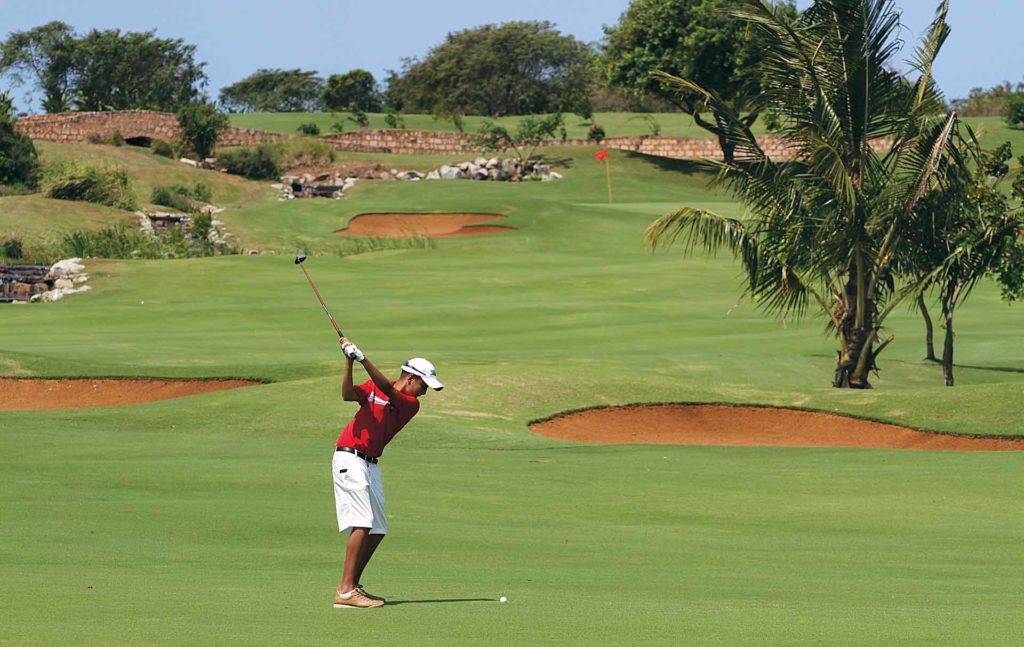
Golfing holiday in Kenya
Kenya has always been the ultimate safari land: a place of magical creatures, ancient cultures, postcard-perfect beaches, and one of the world’s warmest welcomes. But with the opening of several new championship courses and a wealth of luxurious golf estates, Kenya is striding onto the international golfing stage with the swagger of a confident old hand.

Some of the world’s best players have endorsed Kenya as their holiday destination of choice. It’s no surprise that in 2009, Africa’s most celebrated safari country was also voted ‘Undiscovered Golf Destination of the Year’ by the International Golf Travel Writers Association.
Golfing in Kenya - a long history
It was in the year 1906 that the idea for what is now Kenya’s most venerable course, the Royal Nairobi, was conceived. It had a chaotic start in life: mistakenly located in a swamp, it was then infested by lions. Golfing in Kenya had begun.
Thereafter, golf courses sprang into life all over Kenya. Most still exist and they’re as eclectic a selection as you’ll find anywhere on earth. Some rise from rolling hills green-quilted with tea. Others float amid a sea of coffee plantations. Some lie on the shores of flamingo-fringed lakes, others cling to the flanks of dormant volcanoes. One, the now famous Sigona Golf Course, was built around an elephant watering hole. Another, built on the shores of the vast soda lake known as Magadi, is probably the hottest course on earth.
Kenya, the awakening giant of golf holiday tourism
As Kenya became hailed as the ‘awakening giant’ of international golf tourism, the interest in golfing safaris grew rapidly. A parade of internationally acclaimed golf course designers arrived to create a number of truly revolutionary courses and, in their wake, came all the big names of golf. The Muthaiga Golf Club hosted the Masters Champions: Seve Ballesteros (1978), Ian Woosnam (1986) and Trevor Immelman (2000). While in 1969 Karen Country Club served as the venue for a triangular match between Roberto de Vicenzo, Bert Yancey and Tony Jacklin. A golfing holiday in Kenya was now high on the list of every keen golfer.
‘Playing golf in Kenya is a wonderfully evocative experience that every golf traveller will cherish. There is such variety, not only between the city and the coast, but between individual courses.’
Peter Walton, CEO International Association of Golf Tour Operators
In 2009, when Kenya was voted the ‘Undiscovered Golf Destination of the Year’ by the International Golf Travel Writers Association, fame spread even further. Now everyone wanted to tee off from under the nose of a hippopotamus (Kenya’s golfing rules allow you to take a second shot if interrupted by a hippopotamus) or under the watchful eye of a Sykes monkey.
A golfing holiday in Kenya - the top ten Kenyan courses
According to the golfing cognoscenti, (and specifically Jim McCann, Editor of Top 100 Golf Courses Magazine), the top ten 18-hole courses are - in no particular order:
1. Vipingo Ridge (Baobab Course) - North Coast
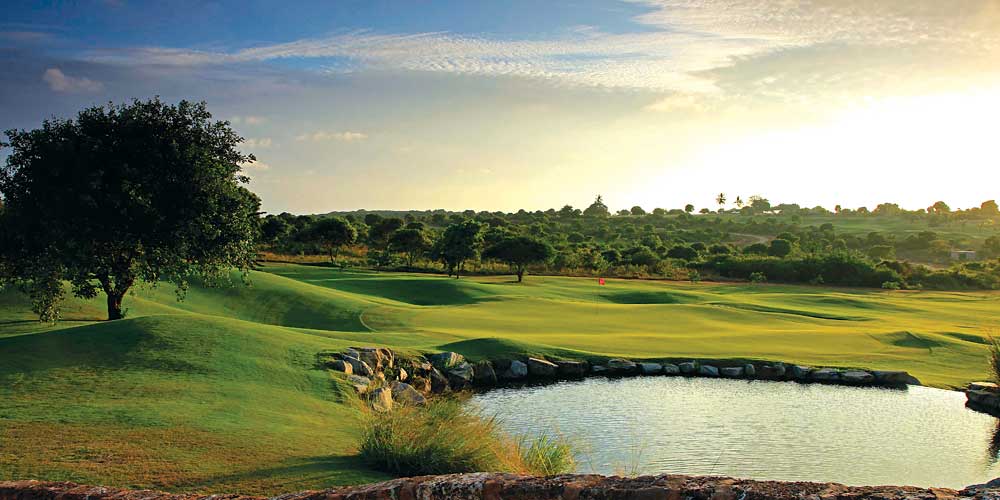
Idyllically situated on the cliffs overlooking the Indian Ocean, this course was designed by David Jones and was the first in Africa to obtain PGA accreditation in 2016. Described as a marvel of engineering, wherein the water gently cascades from its highest to its lowest point, this former sisal plantation has been transformed into a superlative resort with restaurants, bars, accommodation and more.
‘The natural beauty, the stunning new course, and the amazing facilities at Vipingo Ridge have all inspired me to build a holiday home here. I believe this is one of the most beautiful coastal courses anywhere in the world.’
Ian Woosnam OBE, former World No.1 and US Masters Champion
- 18 holes, par 72
- Altitude: 125 metres (410 feet)
- Tee distance (championship): 7,314 yards
2. Muthaiga Golf Club - Nairobi
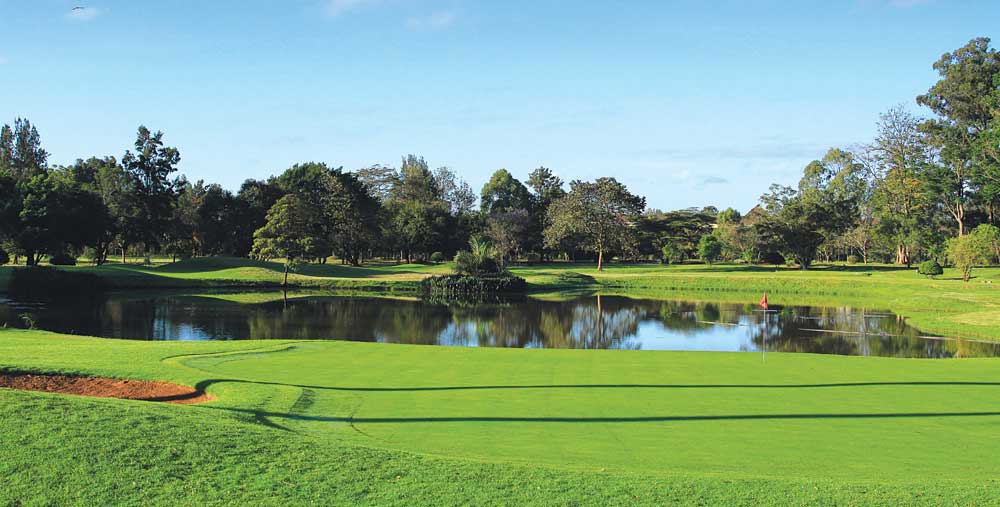
Established in 1913 and reputed to be the ‘prettiest course in East Africa’, this is the Grande Dame of Kenya courses and hosts the Kenyan Open, a professional event held regularly since it became part of the European PGA Challenge Tour in 1991.
- 18 holes, par 71
- Altitude: 1,710 metres
- Tee distance (championship): 7,169 yards
3. Sigona Golf Club - Nairobi
Picturesquely perched on the lip of the Great Rift Valley just outside Nairobi this course, once a wattle plantation, was designed by the accomplished English course designer, Tom Simpson and opened in 1938. Reputed to be ‘tough’ not least because it is six-and-a-half-thousand-feet above sea level.
- 18 holes, par 72
- Altitude: 1,980 metres
- Tee distance (men’s): 6,890 yards
4. Karen Country Club - Nairobi
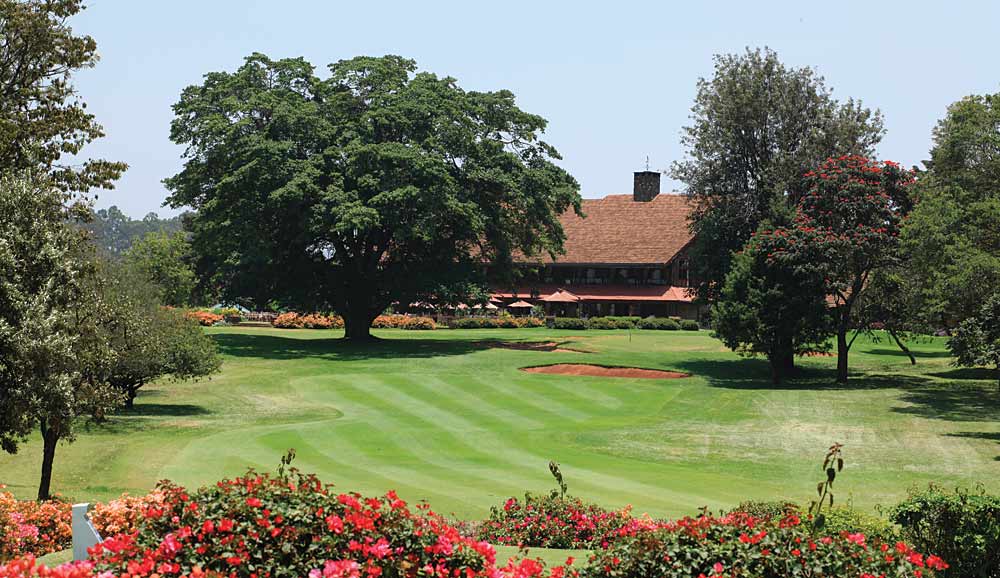
Established in 1937, this course occupies the former coffee plantation of Baroness Karen Blixen, whose memoir ‘Out of Africa’ was made into the epic 1985 film of the same name. Renovated by David Jones, it offers a challenging and beautiful game.
- 18 holes, par 72
- Altitude: 1,830 metres
- Tee distance (championship): 6,924 yards
5. Nyali Golf & Country Club - Mombasa
Just north of Mombasa on the Indian Ocean coastline this course was established in 1940 and planted entirely with Polana grass from Mozambique. And it still is. Nyali is famous for its Madagascan flame trees, sea views and vervet monkeys.
- 18 holes, par 71
- Altitude: sea level
- Tee distance (championship): 6,715 yards
6. Windsor Golf Hotel & Country Club - Nairobi

Designed by the acclaimed Tom Macauley to championship standard and length, this course features forests and coffee plantations while the resort, just outside Nairobi, is a triumph in convincing you you’re NOT in Nairobi.
- 18 holes, par 72
- Altitude: 1,830 metres
- Tee distance (championship): 7,290 yards
7. Limuru Country Club - Limuru
Close to Nairobi and beloved for its spectacular tree-lined fairways and rolling vistas of farmland and tea country, this course was established in 1940 and hosted the prestigious Africa Amateur Team Championship in 2015.
- 18 holes, par 71
- Altitude: 2,135 metres
- Tee distance (men’s): 6,739 yards
8. Great Rift Valley Lodge & Golf Resort - Naivasha
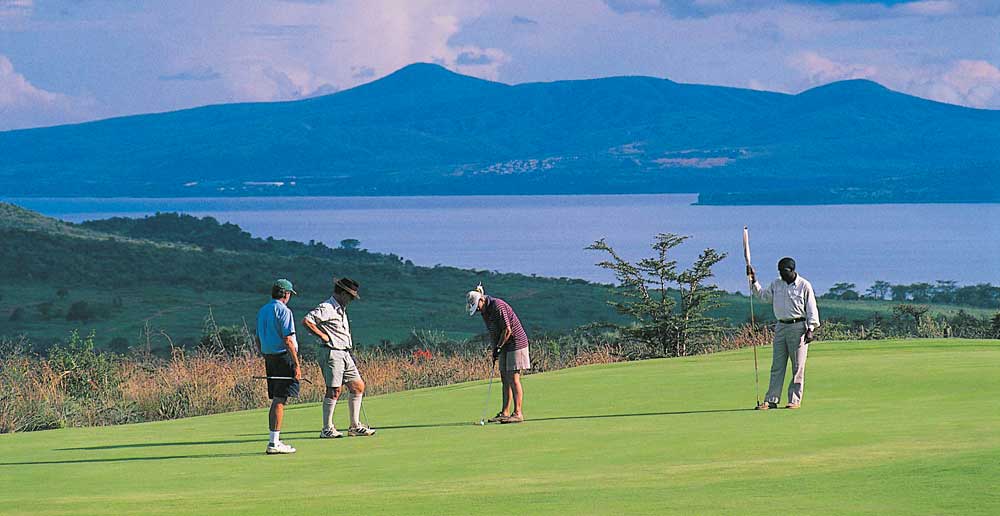
Kenya’s most spectacular course, this magnificent course offers stunning views of the dormant volcano Mount Longonot and the storm-lashed waters of mesmeric Lake Naivasha. Designed by Tom Macauley, it caused its builder Thomas Fjastad great stress due to the fascination it exercised over the local buffalos.
- 18 holes, par 71
- Altitude: 2,088 metres
- Tee distance (championship): 7,107 yards
9. Leisure Lodge Beach & Golf Resort - Diani Beach
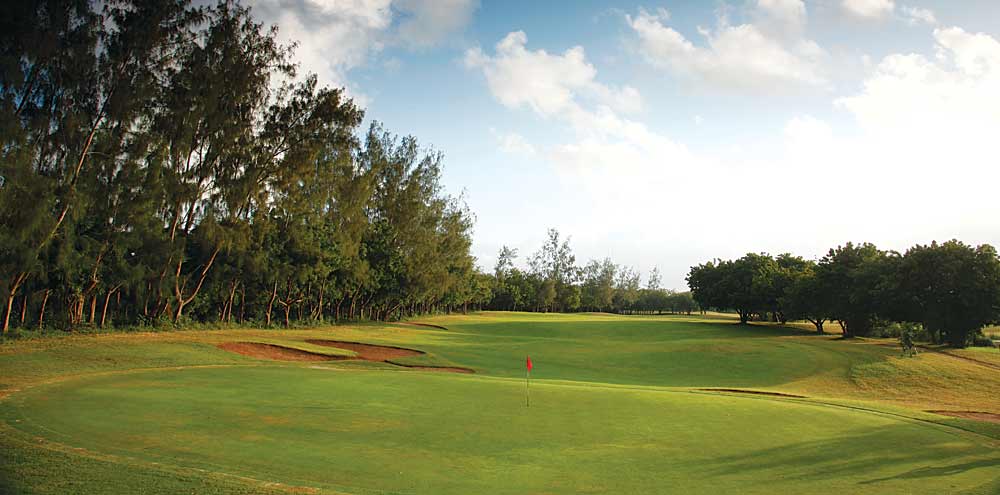
A cliff top course with stunning views over the Indian Ocean this course allows you to get from the 18th hole to the beach in minutes. And what a beach it is. Situated on Kenya’s most famous beach, Diani, Leisure Lodge has it all.
- 18 holes, par 72
- Altitude: sea level
- Tee distance (championship): 6,632 yards
10. Royal Nairobi Golf Club - Nairobi
In the heart of East Africa’s most vibrant capital, easily reached from all the downtown hotels, this is Kenya’s oldest and most respected course.
- 18 holes, par 72
- Altitude: 1,795 metres
- Tee distance (championship): 7,021 yards
Want Inspiration in your Inbox?
Sign up for FREE to receive our monthly e-newsletter with features
and ideas to help you plan your Kenyan adventure
© 2024 Kenya Holidays
